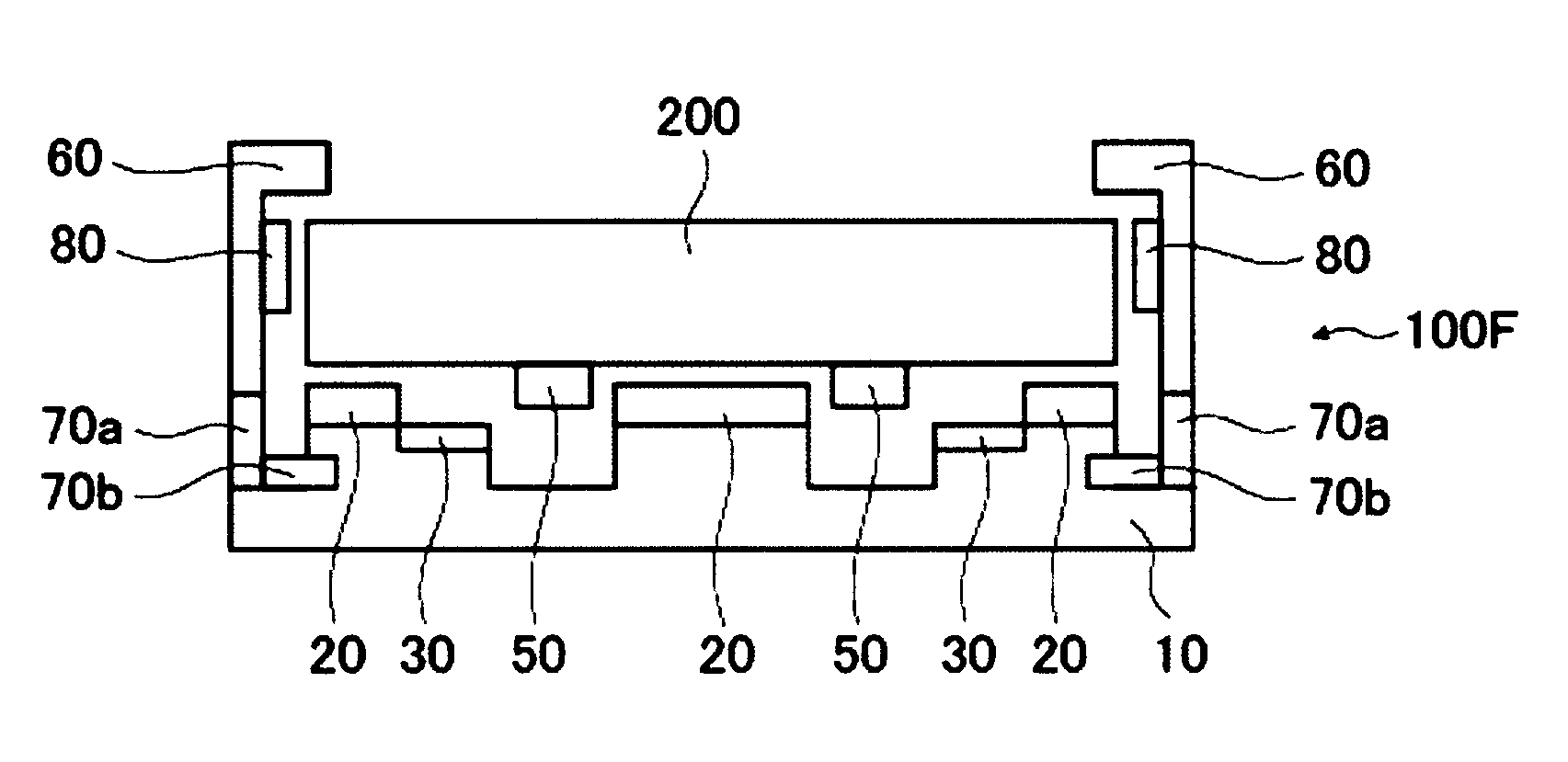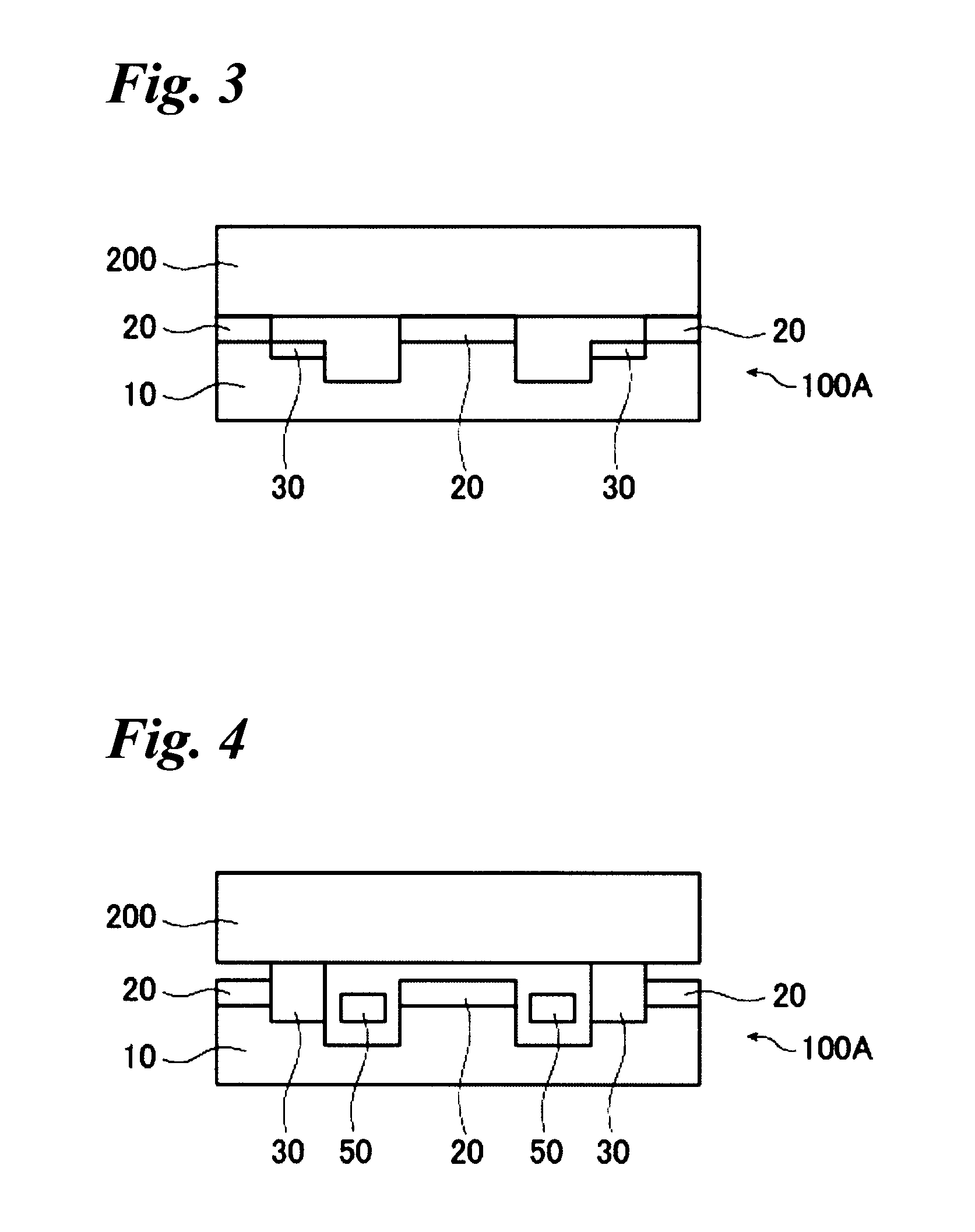Glass substrate-holding tool
a technology of holding tools and glass substrates, which is applied in the direction of printing tools, instruments, manufacturing tools, etc., can solve the problems of glass substrate holding tools, dusting, and scratches on film-forming surfaces, and achieve the effect of preventing dusting and preventing dusting
- Summary
- Abstract
- Description
- Claims
- Application Information
AI Technical Summary
Benefits of technology
Problems solved by technology
Method used
Image
Examples
example 1
[0179]In Example 1, a glass substrate-holding tool 100B shown in FIG. 5 is prepared. By a silicone resin, a catching portion 20 is formed at the periphery of the base 10 made of aluminum oxide and having a size of 6 inch (152.4 mm) square. The silicone resin used has a catching force F0 per unit surface area of 4 gf / mm2, and the catching portion 20 has a width of 1.5 mm and a height of 1 mm. Accordingly, the contact area S of the catching portion 20 to the glass substrate is about 902 mm2. Further, from the above formula (2), the substrate-catching force F by the catching portion 20 is about 3,608 gf.
[0180]At four corners of the base 10, circular lifting up mechanisms 30 having a diameter of 1 mm are provided to release the glass substrate 200 from the catching portion 20.
[0181]By means of the glass substrate-holding tool 100B thus prepared, a glass substrate for an EUV mask blank is catched and held. For the glass substrate 200, a SiO2—TiO2 glass substrate having a size of 6 inch (...
example 2
[0184]In Example 2, a glass substrate-holding tool 100C shown in FIG. 6 is prepared. A glass substrate-holding tool is prepared in the same procedure as in Example 1 except that a base 10 wherein grooves 40 with a width of 19 mm are provided to let arms 50 for transporting a substrate pass therethrough. Accordingly, the contact area S of the catching portion 20 to the glass substrate is about 788 mm2, and the substrate-catching force F by the catching portion 20 is about 3,152 gf.
[0185]In the same procedure as in Example 1, catching and holding of a glass substrate are carried out, and the number of defects of at least 200 nm, increased after the catching and holding is evaluated. The result is 0 like in Example 1.
[0186]In the same procedure as above, the catching and holding of the glass substrate are repeated ten times, but no displacement or falling of the glass substrate from the base 10 of the catching and holding tool 100C is observed, and no deterioration of the catching rete...
example 3
[0187]In Example 3, a glass substrate-holding tool 100A shown in FIGS. 1 to 4 is prepared. In the same manner as in Example 2, by using a base 10 wherein grooves 40 are provided to let arms for transporting a substrate pass therethrough, by the same silicone resin as in Examples 1 and 2, a catching portion 20 is formed at a part of the periphery of the base 10. The width of the catching portion 20 is made to be 2 mm, the height is made to be 1 mm, and the total contact area S of the catching portion 20 to the glass substrate is about 760 mm2. Near the grooves 40, lifting up mechanisms 30 are provided. The substrate-catching force F by the catching portion 20 becomes about 3,040 gf.
[0188]In the same procedure as in Examples 1 and 2, the catching and holding of a glass substrate are carried out, and the number of defects of at least 200 nm increased after the catching and holding is evaluated, and the result is 0 like in Examples 1 and 2.
[0189]In the same procedure as above, the catch...
PUM
| Property | Measurement | Unit |
|---|---|---|
| contact area | aaaaa | aaaaa |
| diameters | aaaaa | aaaaa |
| diameters | aaaaa | aaaaa |
Abstract
Description
Claims
Application Information
 Login to View More
Login to View More - R&D
- Intellectual Property
- Life Sciences
- Materials
- Tech Scout
- Unparalleled Data Quality
- Higher Quality Content
- 60% Fewer Hallucinations
Browse by: Latest US Patents, China's latest patents, Technical Efficacy Thesaurus, Application Domain, Technology Topic, Popular Technical Reports.
© 2025 PatSnap. All rights reserved.Legal|Privacy policy|Modern Slavery Act Transparency Statement|Sitemap|About US| Contact US: help@patsnap.com



